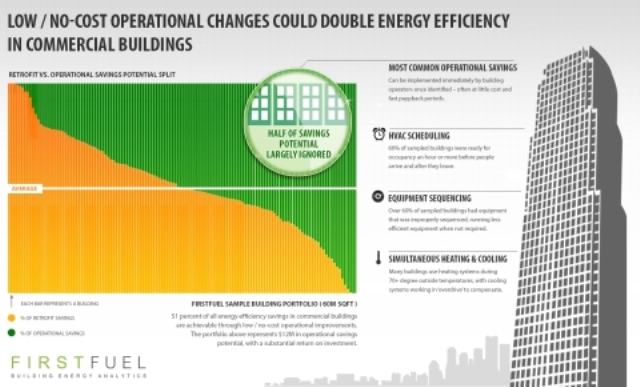Feb 7 2013
FirstFuel Software, the market-leading building energy analytics company, today announced that half of all energy efficiency savings in commercial buildings are achievable through operational improvements, at little or no cost to building owners and operators. This finding is drawn from an analysis of a representative sampling of buildings from FirstFuel’s utility and government customers, which is available for download through the accompanying FirstFuel Operational Savings Infographic.
 FirstFuel's analysis of 60 million square feet reveals that half of all energy efficiency savings in commercial buildings are achievable through operational improvements, at little or no cost to building owners and operators. (Graphic: Business Wire)
FirstFuel's analysis of 60 million square feet reveals that half of all energy efficiency savings in commercial buildings are achievable through operational improvements, at little or no cost to building owners and operators. (Graphic: Business Wire)
“While building retrofits remain the primary focus within commercial energy efficiency, our deep analysis of interval data reveals that a vast savings opportunity still remains largely untouched,” said Swapnil Shah, co-founder and CEO of FirstFuel. “These findings show that the commercial building sector has a chance to essentially double the potential for energy savings, while simultaneously slashing efficiency implementation costs by a significant margin.”
Achieving Energy Efficiency Through Operational Changes
Using its Remote Building Analytics (RBA) platform, FirstFuel performed complete, zero-touch audits of the commercial building sample, using only utility meter data. The sample accounted for more than 60 million square feet, and represented a balance cross-section of the medium and large U.S. commercial market in terms of building size, building type, and geography. According to the U.S. Department of Energy, commercial buildings consumed 19 percent of all energy in the U.S. in 2011.1
The FirstFuel analysis revealed that 51 percent of all energy efficiency opportunities from the sample – representing over $12 million in savings– could be achieved through low and no-cost operational improvements. When extrapolated to the entire U.S. commercial building market, the total savings potential for operational improvements represents a $17 billion opportunity.
FirstFuel’s analysis also yielded insights into the most common operational savings opportunities. These building inefficiencies are often difficult to uncover, but can be implemented immediately by building operators once identified:
- HVAC Scheduling – Nearly 60 percent of sampled buildings were ready for occupancy more than an hour before people arrived and commonly ran for two-to-four hours after people left the building. Coordination of building automation with occupancy represented nearly 20 percent of the total operational savings opportunity identified in the analysis.
- Equipment Sequencing – In buildings with multiple forms of heating or multiple stages of cooling, the equipment was often improperly sequenced, running the less efficient equipment when not required. More than 60 percent of sampled buildings demonstrated equipment sequencing inefficiencies.
- Simultaneous Heating and Cooling – Efficient buildings transition from heating to cooling at a defined temperature. FirstFuel’s analysis revealed that heating and cooling often run simultaneously around that transition temperature, especially in buildings with electric heat. In numerous instances, buildings were still using heating systems during outside temperatures of 70+ degrees, with building cooling systems working in “overdrive” to compensate for the over-heated air.
FirstFuel’s market-leading Remote Building Analytics platform uses advanced analytics on utility interval meter data to identify, enable, and track energy efficiency savings behind the meter in commercial buildings – all without onsite visits or device installations. The company is working with over half-a-dozen of North America’s largest utilities and two government customers, including the Department of Defense, to identify major operational and retrofit savings opportunities.
“Utilities in regulated and de-regulated markets, as well as government agencies, are recognizing how operational improvements in commercial buildings can help them meet targets in a highly cost-effective and impactful manner,” added Shah. “More and more, they see taking full advantage of operational savings as the best path forward.”